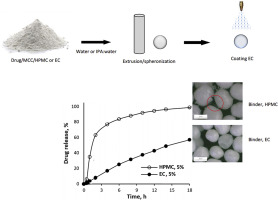Water-soluble and -insoluble polymers as binders for pellet preparation by extrusion/spheronization

The objective of this study was to investigate the effect of binder (water-soluble vs. -insoluble) and granulation fluid (aqueous vs. organic) on the physical properties of pellet prepared by extrusion/spheronization and on drug release. Size distribution, sphericity, bulk density, crushing force and swellability of the pellets were investigated. Pellets prepared with IPA:water as a granulation fluid were less dense, weaker than those prepared with water. The pellets prepared with water as the granulation fluid demonstrated higher swelling than those prepared with IPA:water irrespective of the drug loading and binder content. To achieve release retardation, pellets were coated with EC having a thickness according to the drug solubility, except those contained carbamazepine. When IPA:water was used as a granulation fluid instead of water, carbamazepine release was increased and propranolol HCl release was decreased. Pellets prepared with HPMC as the binder swelled and damaged the thin EC coat in resulted in a fast release. Hence, to avoid higher coating level, EC of higher molecular weight was used. It is concluded that binder type and granulation fluid had a great impact on physical properties and drug release from pellets prepared by extrusion/spheronization.

